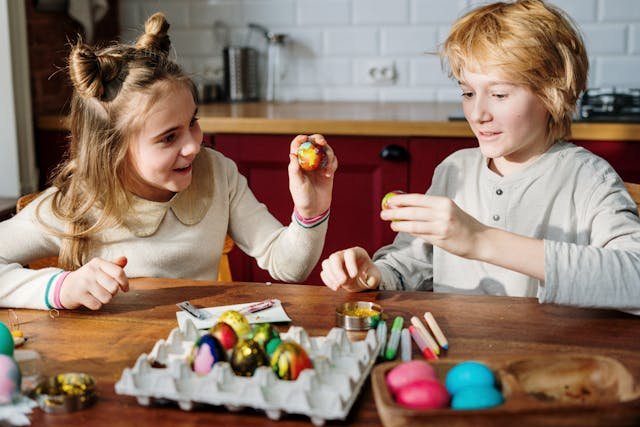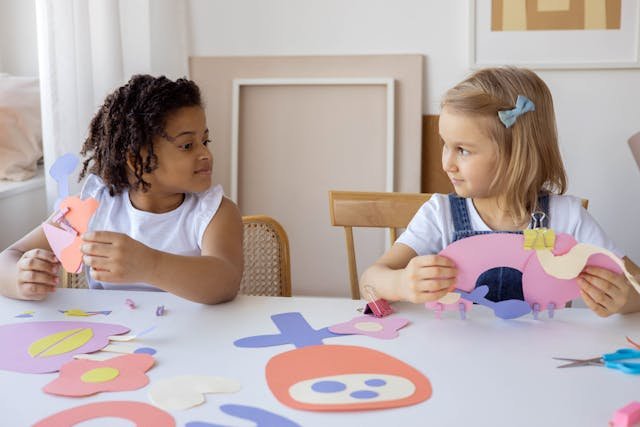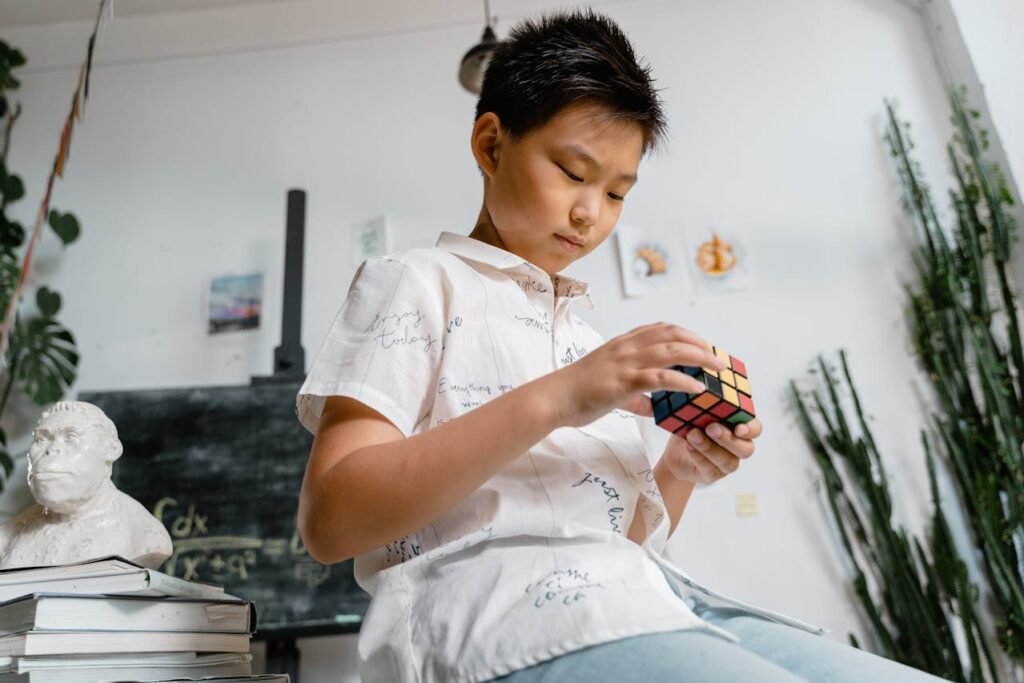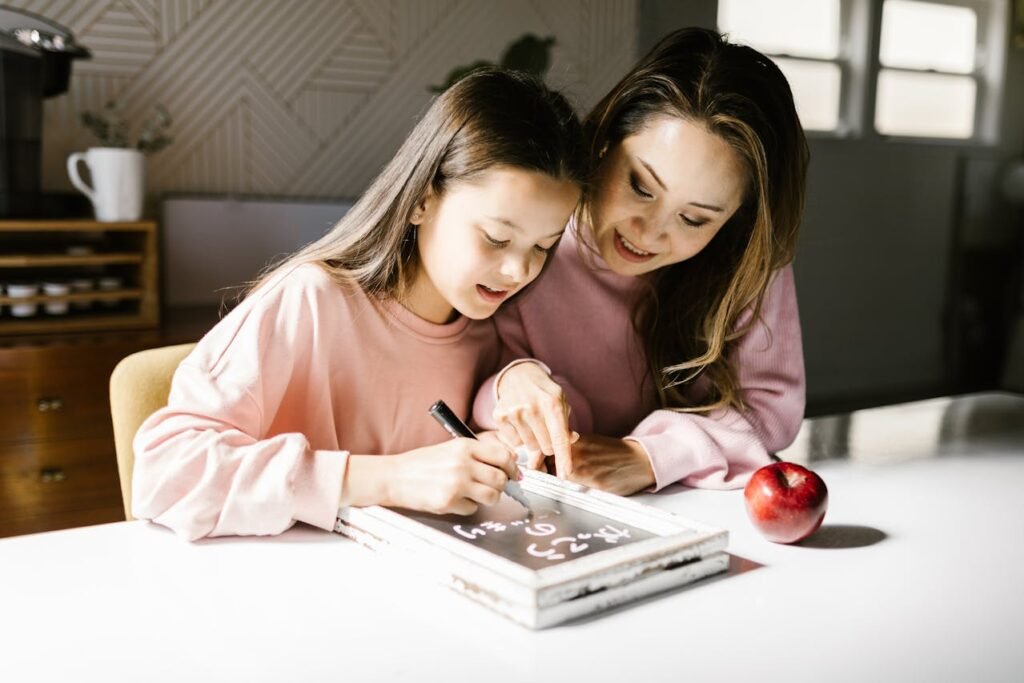Have you ever watched a group of kids working together on a task—maybe building a puzzle, doing homework, or just playing a game—and noticed how much they learn from each other? It’s like little sparks go off in their minds. They ask questions, give answers, solve problems, and even teach each other without realizing it.
That’s the power of peer interaction. It’s more than just playtime. It’s a big part of how kids grow smarter, faster, and more confident in how they think.
In simple words, peer interaction helps shape how a child’s brain develops—how they understand things, solve problems, remember ideas, and even how they speak or ask questions. When kids learn together, they learn better.
At Debsie, we use this idea in everything we do—our live classes, group challenges, and even in our gamified learning labs. Because we know: when kids talk, work, and think with others their age, magic happens.
Why Talking With Other Kids Helps the Brain Grow
Imagine a child trying to solve a puzzle alone. They think, try, maybe get stuck, and try again. That’s one way to learn. Now imagine the same child sitting with two friends. One says, “Let’s try this piece!” Another says, “No, it doesn’t fit—try this side!” Now they’re talking, thinking, testing ideas, and solving it together.
That’s what we call social thinking—when kids learn by sharing thoughts with other kids.
This kind of back-and-forth is more than just conversation. It’s brain exercise. When children talk with each other, they are:
- Listening to different ideas
- Comparing thoughts
- Explaining their thinking
- Fixing mistakes by seeing what others do
- Asking questions they may not have thought of alone
And guess what? Each of these small steps helps build something big inside their brain: cognitive growth. That means stronger memory, better problem-solving, and clearer thinking.
So, it’s not just what kids learn—it’s how they learn it, and who they learn it with.
The Science Behind Peer Learning
You don’t need to be a brain expert to understand why kids learn better when they learn with other kids. But there’s some really fascinating science behind it—and it all starts with one key idea:
Children learn best when they are slightly challenged—just enough to stretch, but not enough to feel stuck.
This idea comes from a famous learning expert named Lev Vygotsky, who talked about something called the Zone of Proximal Development, or ZPD. Sounds fancy, right? But here’s what it really means in simple words:
The Zone of Proximal Development (ZPD)
Imagine your child is standing on a ladder. The step they’re standing on is what they can do all by themselves. The next step up? That’s something they can’t do alone yet, but they can do it with a little help.
That “middle space” between what they can do alone and what they can do with help? That’s the ZPD.
And who can give that help? A teacher, yes—but also a peer.
Sometimes, learning from another child is even better because:
- It feels more relatable
- The language is simpler
- There’s less pressure
- The pace is more comfortable
A child who is just one small step ahead can explain things in a way that clicks.
This is why peer learning works so well—it takes place right in that ZPD sweet spot.
Peer Scaffolding: How Kids Help Each Other Climb
Another powerful idea from brain science is scaffolding. When a building is being made, workers use scaffolds (those metal frames) to reach higher safely. In learning, scaffolding means giving just enough support to help someone move forward.
In peer learning, kids become scaffolds for each other.
- One child shows a new strategy in math
- Another explains a tricky word in reading
- A third models how to solve a science problem step by step
Each small help builds a stronger foundation for thinking.
And here’s the fun part: both children grow. The one giving help strengthens their understanding by explaining it, and the one receiving help gets a chance to learn in a safe, friendly way.
Mirror Neurons: Why Kids Copy Each Other Naturally
There’s another bit of science that helps explain peer learning: mirror neurons.
These are special brain cells that “light up” when we watch someone do something—like tie a shoe, clap their hands, or solve a puzzle. It’s our brain’s way of saying, “I see it… and now I want to try it too.”
That’s why when a child sees another child learning, speaking up, or solving something, their brain quietly says, “Hey, I can do that too.”
This isn’t just copying. It’s brain-based motivation. Peer learning taps into it naturally.
The More They Share, The More They Understand
One last big idea from the science: explaining strengthens memory.
When a child explains something to a peer, they’re not just helping the other person—they’re helping themselves. That process of putting thoughts into words forces the brain to organize, reflect, and make stronger connections.
It’s like going from knowing it to owning it.
At Debsie, we build peer explanations into many lessons. Kids teach each other mini-concepts during live classes. They work in pairs to review tricky terms. And they even submit video responses where they explain their thinking—because teaching others is one of the fastest ways to learn deeply.
Real-Life Example: Learning Fractions Together
Let’s say two kids are trying to learn fractions. One is just getting started. The other one already understands a bit.
The first child says, “I don’t get what one-half means.”
The second child draws a circle, colors half of it, and says, “See? If we cut this pizza into 2 equal parts, each part is a half.”
Suddenly, it clicks. Not because the teacher explained it again. But because a friend said it in a way that made sense.
That’s peer interaction at work. And it’s beautiful to watch.
Why Peer Interaction Feels Safer for Many Kids
One of the reasons kids open up more with other kids is because it feels less scary. Talking to a teacher or parent can sometimes make a child nervous. They might worry about giving the wrong answer or being judged. But with a friend, they feel more relaxed.
That safe feeling is important.
When kids feel safe, their brain can focus better. They’re not worried about making mistakes. They’re just thinking, trying, and learning. This is why peer interaction doesn’t just help with schoolwork—it builds confidence too.
When a child sees another child make a mistake and laugh it off, they learn that it’s okay to try. When they hear a friend say “I don’t know either,” they realize they’re not alone. That kind of support builds emotional safety, and emotional safety opens the door to better thinking.
This is something we care deeply about at Debsie. In our group classes, we set up small learning circles where every child feels seen and heard. No raised hands needed. Just friendly sharing, playful tasks, and quiet moments where a child can say, “I think I get it now.”
And when that moment comes? It’s like a lightbulb turning on.
Peer Interaction Isn’t Just for Group Projects
Sometimes, people think peer learning only happens during group work or class discussions. But it can happen in small, quiet ways too.
Like:
- Two friends reading together and asking each other questions.
- A group of kids watching a science video and pausing to chat about what they see.
- A quick chat during a math game where one child says, “Oh! I see what you did!”
Even short moments of interaction can spark a big idea. Because learning doesn’t always need a chalkboard. Sometimes, it just needs a buddy who says, “Try it like this.”
That’s why Debsie’s platform is designed to encourage ongoing peer exchange—not just once a week, but every day. Kids interact during challenges, share answers, give feedback in safe and friendly ways, and even collaborate on coding tasks or science puzzles.
They’re not just learning facts. They’re learning how to think together. And that’s a life skill.
A Quiet Child Can Still Benefit
Now, you may wonder—what about shy kids? The ones who don’t speak much in groups?
Great question.
Shy children don’t need to talk a lot to learn from others. Even listening to peers can help them grow. They hear different ways of thinking. They compare their own ideas. And slowly, when they’re ready, they begin to share too.
In Debsie’s live sessions, we give these children space. They’re not forced to speak. But when they do, we listen. And we cheer them on.
Because even the quietest child has a loud, smart mind inside—just waiting for the right moment to shine.
How Peer Interaction Builds Thinking Muscles
When kids learn from each other, something interesting happens—they stop just memorizing and start thinking. Their brain begins to work in new ways. Why? Because learning with peers often leads to questions like:
- “Why did you do it that way?”
- “What happens if we try this?”
- “How come that worked for you but not for me?”
These questions are gold. They push children to explain, not just repeat. And when a child explains something, they understand it much more deeply.
Let’s say two kids are solving a science problem about plants. One says, “Plants need water and sunlight.” The other asks, “Why sunlight?” The first child has to think, pause, and say, “Because it helps them make food through… oh yeah, photosynthesis!”
That thinking pause? That’s the brain growing.
At Debsie, we love that moment. We call it the “click.” It’s when something confusing suddenly becomes clear. And very often, that click happens during a chat between students—not during a lecture.
So, peer interaction doesn’t just pass on facts—it sharpens the brain. It builds what we call thinking muscles.
And thinking muscles are what help kids solve problems in math, write better stories, figure out tricky science ideas, and even understand the world around them.
Learning Is Sticky When It’s Shared
Let’s be honest—most of us forget things we learn in school unless it really meant something to us.
Kids are the same. If they just hear something and move on, it often slips away. But when they talk about it, play with it, or teach it to someone else? That’s when it sticks.
That’s what we mean when we say learning becomes “sticky.”
Think about this:
A child reads a lesson on climate change. Okay, they may remember some of it. But if they talk about it with classmates, act out a scene, or create a poster together? That knowledge becomes part of them. They own it. Because they didn’t just read it—they shared it.
That’s why Debsie’s lessons are built to be social and fun. After a topic is introduced, kids get to talk, build, quiz, teach, and laugh. We keep it active. We keep it shared. And that’s why it sticks.
Learning With Peers Builds More Than Just Smarts
Peer interaction doesn’t only grow thinking. It grows hearts too.
When kids work together, they learn:
- How to listen
- How to wait their turn
- How to respect different views
- How to handle mistakes together
- How to cheer others on
These are life skills. They help children grow into kind, thoughtful, strong humans.
And when you think about it… isn’t that what learning is all about?
What Peer Learning Looks Like at Debsie
At Debsie, we don’t just hope kids will interact—we build our whole platform around it. Peer learning isn’t something extra. It’s at the heart of everything we do.
Let’s take a look at how this works in real life:
In Our Live Classes
Our teachers don’t just talk at students. They guide them to talk to each other. After teaching a topic, they might say:
- “Turn to your group and explain this in your own words.”
- “Can someone help their classmate solve this step?”
- “Work together to come up with a real-world example.”
These small tasks create big impact. Kids begin to connect, share, and grow—right there in the moment.
And the best part? Kids learn that it’s okay not to have all the answers. It’s okay to learn with others, not just from them.
In Our Gamified Challenges
Peer interaction doesn’t stop when class ends.
Our self-paced learning labs and challenges are designed to be interactive. Children can:
- Team up to beat a science mission
- Share solutions to tricky math puzzles
- Give tips to others in coding adventures
It feels like a game—but it’s serious learning underneath.
They’re talking, thinking, explaining, laughing—and learning without even realizing it. That’s the sweet spot.
In Our Global Learning Community
Debsie is global. Kids from different countries come together in one learning space. And when kids learn from different cultures, languages, and ways of thinking, their minds grow even more.
They get to say things like:
- “Oh, I didn’t know you did it that way!”
- “That’s a cool example from your country!”
- “Let me show you how I solved it.”
These small moments make learning exciting. They also build empathy and understanding—something this world needs more of.
But What If Peer Learning Goes Wrong?
Sometimes, peer learning can feel tricky.
What if one child is too quiet? What if someone dominates the group? What if kids disagree?
These are real concerns. But they’re also chances to grow.
At Debsie, we train our partner teachers to guide these moments with care. If a child is too quiet, we gently bring them in. If someone is taking over, we help balance the group. If there’s conflict, we turn it into a learning opportunity.
Because conflict is part of growth, too.
When handled with love and structure, even messy peer moments can teach kids how to:
- Work through challenges
- Listen without interrupting
- Express ideas clearly
- Respect other people’s space
These are lessons they’ll use their whole life—at school, at home, and in the world.
How You Can Support Peer Learning at Home
Peer interaction doesn’t just have to happen in school or during online classes. You can create simple, powerful learning moments right at home—even if your child isn’t part of a big group. These small experiences can shape how they think, how they express themselves, and how they solve problems with others.
Here’s how you can make it happen:
1. Host Mini Learning Meetups
It doesn’t have to be a big event. Just invite one or two of your child’s classmates or neighborhood friends over for a playdate with a twist. Instead of just playing with toys, let them:
- Build something together with blocks or LEGO
- Work on a science kit or experiment
- Try a simple cooking activity that involves measurements and steps
- Watch an educational video and chat about it after
The key is to let them figure things out together, ask questions, and make little mistakes. You don’t need to guide everything. Just sit back and watch how their thinking grows when they talk things through with each other.
2. Use Sibling Power
If you have more than one child, peer learning can happen naturally between siblings—even if they are different ages.
- Let your older child “teach” a topic they learned at school to their younger sibling. This builds confidence in the older one and curiosity in the younger.
- Ask the younger one to explain what they see in a picture book or a drawing. The older sibling can listen, support, and add more ideas.
Even these tiny moments of shared learning can build communication, patience, and understanding.
3. Join Online Learning Communities Like Debsie
One of the best ways to bring in healthy peer learning at home is through guided online classes where your child can interact with others in a safe space.
At Debsie, every live class and digital course is designed with peer engagement in mind. Kids don’t just watch—they join small groups, discuss ideas, and build projects together with students from different places.
This kind of learning is:
- Structured by expert teachers
- Safe and friendly
- Fun and interactive
- Designed to encourage teamwork, not just test scores
So even if your child is learning from home, they don’t have to learn alone.
4. Create a “Think-Aloud” Habit
You can encourage peer-style learning even during regular conversations. Here’s how:
- When your child is solving something (like a riddle or a tricky homework question), ask them to “think out loud.”
- If you’re doing something with them (like playing a game or building something), talk through your own steps too.
This teaches them to explain their thinking, which is a key part of learning with others. And over time, they’ll do this naturally with their peers too.
5. Praise Team Efforts, Not Just Results
When your child works with a friend or sibling to complete something, celebrate the process—not just the final answer.
Say things like:
- “I love how you two worked that out together.”
- “You asked a great question just now.”
- “I saw you helping your friend understand it—that was kind.”
This teaches them that learning is about teamwork, not perfection. And that makes them more open to sharing, helping, and learning with others in the future.
Final Thoughts: Learning Together, Growing Smarter
When children learn with other children, something powerful happens. They stop feeling alone. They start to think bigger. They try harder. They speak up. They listen better. They become little leaders, little teachers—and big thinkers.
That’s the heart of peer interaction.
It’s not just about doing group work or sharing answers. It’s about building minds through connection. Every time a child explains an idea, listens to a friend, or solves a problem with a partner, they’re growing their brain in ways that last a lifetime.
At Debsie, we believe that the best learning doesn’t happen in silence. It happens in laughter, in conversation, in teamwork, and in those “Ohhh now I get it!” moments that kids experience when they learn together.
This is why our live classes, challenges, games, and even coding labs are built for real peer interaction—guided gently by expert teachers, but powered by the magic of kids helping kids.
So if you’re looking for a learning space where your child isn’t just taught, but truly engaged, encouraged, and empowered—you’ve found it.
🌱 Let them grow in confidence.
🧠 Let them build stronger thinking.
💬 Let them talk, share, and learn in the way their brain was built to do.
👉 Book your free trial class at Debsie today
And see how your child lights up when learning is shared.
Read Next:



